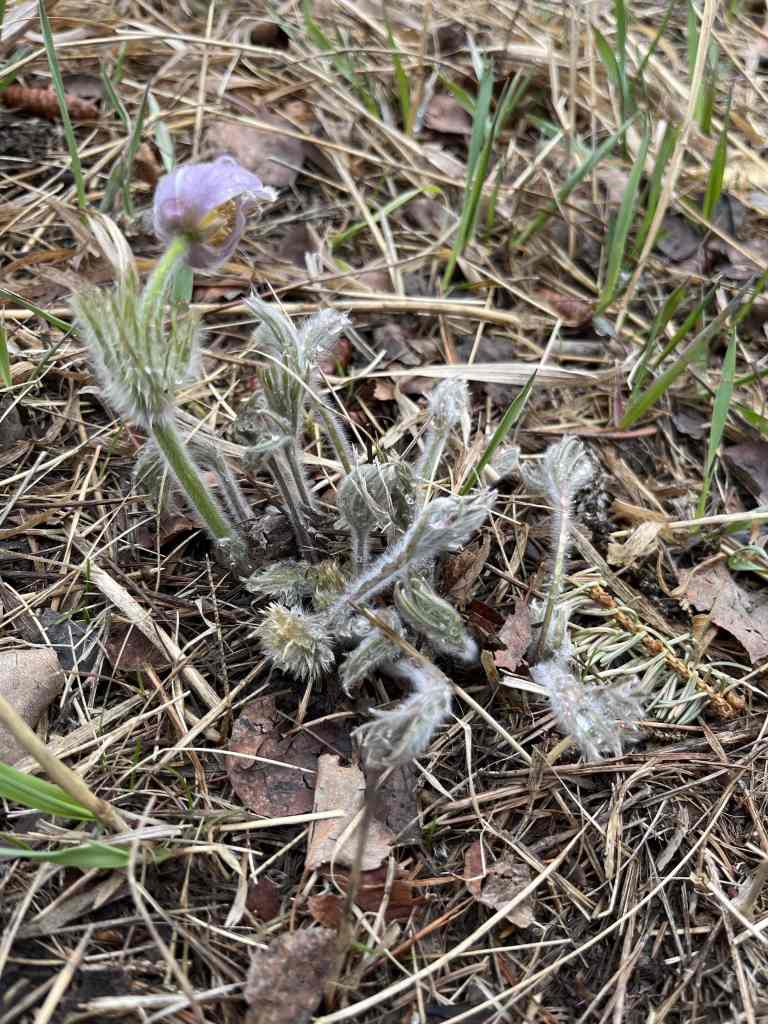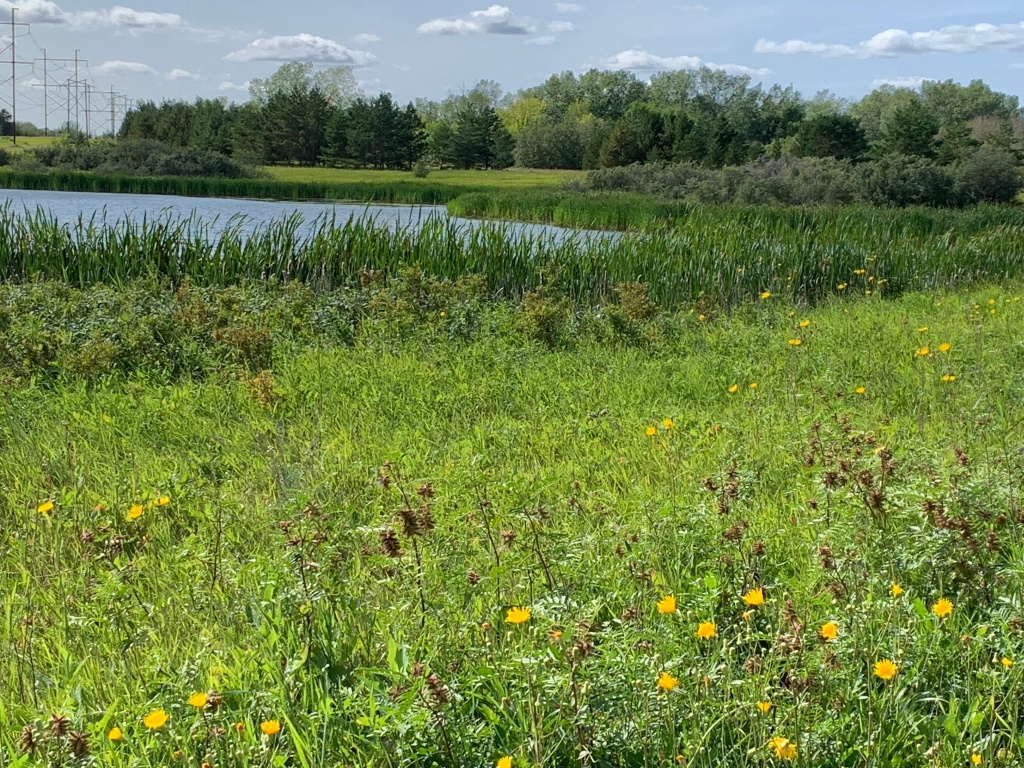In a triumphant display of nature’s resilience, the Richard St. Barbe Baker Afforestation Area has welcomed a stunning newcomer to its diverse ecosystem – the Prairie Pasqueflower (Pulsatilla nuttalliana). This remarkable discovery marks a significant milestone for the area, igniting a wave of excitement and wonder among nature enthusiasts. Perhaps a first in its sighting at this location in decades.
The Prairie Pasqueflower, known for its delicate beauty and rarity, is a botanical gem rarely seen in gardens due to its challenging cultivation requirements. Often mistaken for its European cousin, Pulsatilla vulgaris, this native North American species holds its own unique charm and significance.
Seedlings of the Prairie Pasqueflower are notoriously difficult to transplant, requiring optimal conditions for growth. With an affinity for well-drained soils along with a unique mycorrhizal symbiotic association between a fungus and a plant which is produced with 30 years of uncultivated land and winter snow cover, these resilient blooms thrive in moist to dry environments with a neutral to slightly alkaline pH. Their presence serves as a poignant reminder of the importance of preserving native prairies and their delicate ecosystems.
Historically, the Prairie Pasqueflower has been revered by settlers for its resemblance to the real crocuses found in their homelands, earning it the moniker “prairie crocus.” Additionally known as prairie smoke, cutleaf anemone, windflower, and gosling plant, this versatile flower holds a special place in the hearts of those who cherish the natural heritage of the American prairies. Did you know that, the Blackfoot referred to this flower as Napi, meaning “old man,” drawn by the resemblance of the grey, silky achene seeds of the Prairie Pasqueflower to the grey hair of an elder.
However, the journey of the Prairie Pasqueflower hasn’t been without challenges. Exotic species and invasive plants pose a threat to its survival, highlighting the importance of conservation efforts in protecting its native habitat. The decline of native prairies due to urban development, agriculture, and resource extraction further underscores the urgency of preserving these invaluable green spaces.
Urban areas, despite their limited land cover, hold potential in the conservation of the Prairie Pasqueflower. As human populations continue to grow, the significance of protecting and restoring urban green spaces becomes increasingly evident. Studies have shown a positive correlation between the distance from city centers and the frequency of occurrences of Pulsatilla patens, emphasizing the importance of preserving natural habitats on the outskirts of urban areas.
As we celebrate the arrival of the Prairie Pasqueflower at the Richard St. Barbe Baker Afforestation Area, let us reaffirm our commitment to safeguarding the rich biodiversity of our natural landscapes. Together, through education, conservation, and community engagement, we can ensure that future generations have the privilege of experiencing the beauty and wonder of native flora like the Prairie Pasqueflower. Let this remarkable bloom inspire us to protect and cherish the precious ecosystems that sustain life on our planet.
(Another Layer of Protection for Richard St. Barbe Baker Afforestation Area!)




Bibliography:
- Esparrago Llorca, Javier. “Spatial distribution and habitat preferences of the prairie crocus (Pulsatilla patens) in an urban landscape.” Central European University, 2012. [Online] Available: https://www.etd.ceu.edu/2012/esparrago-llorca_javier.pdf
This study explores the spatial distribution and habitat preferences of the Prairie Pasqueflower in urban landscapes, shedding light on its ecological significance and conservation needs.
- Wildeman, R.L. and Steeves, T.A. “Genetic considerations in the management of Pulsatilla patens (Ranunculaceae).” Canadian Journal of Botany, vol. 60, no. 4, 1982, pp. 485-491.
This article discusses genetic factors influencing the management and conservation of Pulsatilla patens, providing valuable insights into its reproductive biology and population dynamics.
- Native Plant Conservation Campaign. “Pulsatilla patens: Pasque Flower.” [Online] Available: https://www.wildflower.org/plants/result.php?id_plant=PUPA
This resource offers comprehensive information on the Prairie Pasqueflower, including its habitat requirements, cultural significance, and conservation status, sourced from reputable botanical databases.
- Johnson, D.E. “Pulsatilla patens (L.) Mill.: Prairie Pasqueflower.” U.S. Forest Service, 2007. [Online] Available: https://www.fs.fed.us/wildflowers/plant-of-the-week/pulsatilla_patens.shtml
This publication provides an overview of the Prairie Pasqueflower’s morphology, distribution, and ecological role, offering valuable insights into its natural history and conservation implications.
- Turner, M.K. “Prairie Pasqueflower (Pulsatilla patens).” NatureServe Explorer, 2022. [Online] Available: https://explorer.natureserve.org/Taxon/ELEMENT_GLOBAL.2.144481/Pulsatilla_patens
NatureServe Explorer provides detailed species information, including distribution maps, conservation status assessments, and ecological characteristics, contributing to our understanding of the Prairie Pasqueflower’s conservation needs.
Join the #CityNatureChallenge from April 26 to April 29! Document Saskatoon and area’s nature in the free @iNaturalist app by taking photos of wild plants and animals—and help contribute to the world’s largest citizen science event. More at FriendsAreas.ca/events
With thanks to our sponsors and supporters SaskPower, SaskTel, Saskatoon Nature Society, Wild About Saskatoon, Caswell Hill Community Association, SOS Trees Inc., Rosewood Varsity View Community Association, Nutana Varsity View Community Association, Montgomery Place Varsity View Community Association. City Nature Challenge Saskatoon CNC YXE 2024 led by Friends of the Saskatoon Afforestation Areas. Reach if you would like to sponsor the City Nature Challenge, or share the City Nature Challenge information as a collaborator!
#CityNatureChallenge #iNaturalistCanada #Biodiversity Founded by @NHMLA and @CalAcademy Community Science hosted by #friendsdareas #NatureCanada #CityNatureChallenge #BioBlitz #CitSciMonth #CommunityScience #CitizenScience #UrbanNature #UrbanBiodiversity #NatureInTheCity #NatureIsEverywhere #NatureForEveryone #NatureNerd #cnc #outdoors #nature #conservation #photography #biodiversity #citizenscience #inaturalist #wildlife #plantlife #wanderlust #naturelovers #optoutside #instagood #picoftheday #volunteer #training #parks #optingoutside #CNCYXE #CNCYXE2023 #FriendsAreas #FriendsAfforestation #citizenscience #communityscience #EcologicalEmergency #naturelovers @sasktel #inaturalist #saskatchewanbirds #yxebirds #getoutdoors #naturephotography #wildlifephotography #SNS #SaskatoonNatureSociety #citynaturechallenge2023 #yxe #thegreatoutdoors #citynaturechallenge2024 #citynaturechallenge #Canadacitynaturechallenge #citizenscience #Volunteering #nativeprairie #grasslands #wildlife #bees #pollinators #prairiepollinators #ExploreSask #NatureSask #wildlifewatcher #prairielife #sasklife #nativeprairie #speciesatrisk #conservation #KeepSaskWild #socialdistance #citizenscience #wildlifephotography #beesknees #LeavetheLeaves #NoMowMay #nature4all #FriendsAreas #FriendsAfforestation @FriendsAreas #saskatoon #saskatooning#naturelovers #inaturalist #saskatchewanbirds #yxebirds #getoutdoors #naturephotography #wildlifephotography #yxe #thegreatoutdoors #citizenscience #Volunteering #nativeprairie #grasslands #wildlife #bees #pollinators #prairiepollinators #ExploreSask #NatureSask #wildlifewatcher #prairielife #sasklife #nativeprairie #speciesatrisk #conservation #KeepSaskWild #socialdistance #citizenscience #wildlifephotography #beesknees #LeavetheLeaves #NoMowMay #nature4all #FriendsAreas #FriendsAfforestation @FriendsAreas
For directions as to how to drive to “George Genereux” Urban Regional Park
For directions on how to drive to Richard St. Barbe Baker Afforestation Area
For more information:
NEW P4G District Official Community Plan
Richard St. Barbe Baker Afforestation Area is located in Saskatoon, Saskatchewan, Canada north of Cedar Villa Road, within city limits, in the furthest south west area of the city. 52° 06′ 106° 45′
Addresses:
Part SE 23-36-6 – Afforestation Area – 241 Township Road 362-A
Part SE 23-36-6 – SW Off-Leash Recreation Area (Richard St. Barbe Baker Afforestation Area ) – 355 Township Road 362-A
S ½ 22-36-6 Richard St. Barbe Baker Afforestation Area (West of SW OLRA) – 467 Township Road 362-A
NE 21-36-6 “George Genereux” Afforestation Area – 133 Range Road 3063
Wikimapia Map: type in Richard St. Barbe Baker Afforestation Area
Google Maps South West Off Leash area location pin at parking lot
Web page: https://stbarbebaker.wordpress.com
Where is the Richard St. Barbe Baker Afforestation Area? with map
Where is the George Genereux Urban Regional Park (Afforestation Area)?with map
Blogger: FriendsAfforestation
Tumblr friendsafforestation.tumblr.comFacebook Group Page: Users of the George Genereux Urban Regional Park
Facebook: StBarbeBaker Afforestation Area
Facebook for the non profit Charity Friends of the Saskatoon Afforestation Areas Inc. FriendsAreas
Facebook group page : Users of the St Barbe Baker Afforestation Area
Twitter: St Barbe Baker Charity Twitter:FriendsAreas
Please help protect / enhance your afforestation areas, please contact the Friends of the Saskatoon Afforestation Areas Inc. (e-mail / e-transfers )
Donate your old vehicle, here’s how!
Support using Canada Helps
Support via a recycling bottle donation
United Nations Decade on Ecosystem Restoration
- Use the UN Decade’s Visual Identity
- Make it your own
- Spread the word about the UN Decade
- Let’s Bring Back Forests
- Let’s Green Our Cities
““Be like a tree in pursuit of your cause. Stand firm, grip hard, thrust upward. Bend to the winds of heaven..”
Richard St. Barbe Baker






